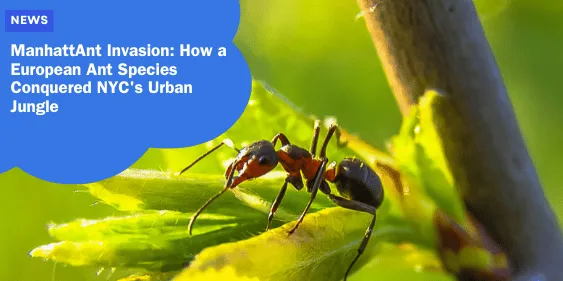ManhattAnt Invasion: How a European Ant Species Conquered NYC’s Urban Jungle

First Spotted in NYC in 2011
Under the bustling streets and towering buildings of New York City, an unexpected visitor made its entrance in 2011.
Researchers carrying out a routine survey on city-dwelling ants stumbled upon a species that was altogether unfamiliar.
The intriguing find?
A small insect with a distinctive black head, abdomen, and a red thorax, an ant that didn’t match any known species native to North America.
Identified as Lasius emarginatus, a European Species
After initial speculation, scientists delved deeper and identified this mysterious ant as Lasius emarginatus, a species native to central Europe.
This discovery was significant. Lasius emarginatus were usually found in forests and fields across Europe, far removed from the urban sprawl of Manhattan.
To confirm the identification, researchers extracted DNA from the ants and compared it with global databases.
Further verification came from coauthor Bernhard Seifert, a leading ant researcher in Germany.
By comparing the New York samples with those native to Europe, Seifert definitively identified the species.
Second Most Common Ant in NYC within a Decade
The rise of the “ManhattAnt” was nothing short of meteoric. Within a decade, it had become the second most common ant species in New York City, surpassed only by the pavement ant (Tetramorium immigrans).
Its rapid proliferation and success in NYC’s challenging urban environment have left scientists fascinated and somewhat concerned about the potential ecological impacts it may exert on local biodiversity.
They theorize that its flexible diet, which includes honeydew from tree-dwelling insects and human food, has facilitated its success.
Having carved out such an important ecological niche in such a short time, the ManhattAnt’s impact extends beyond mere curiosity, making it critical to monitor its spread and adaptations in the city’s unique environment.
As we continue to observe its invasiveness and adaptability, the story of the ManhattAnt offers essential insights into the challenges and dynamics of urban ecosystems and invasive species.
Keep reading to uncover the origins and spread of this intriguing newcomer.
Origin and Spread
Native to Central Europe
The ManhattAnt, formally known as Lasius emarginatus, originates from central Europe.
In its native habitat, this ant species thrives in environments ranging from quiet forests to bustling meadows.
The ManhattAnt first caught the eye of researchers in 2011 during an ant survey in New York City.
Sporting a distinctive appearance, these ants have a black head and abdomen with a red thorax, setting them apart significantly from the native North American ant species.
Accidental Arrival in NYC
So how did these European ants end up in the bustling cityscape of New York?
The most plausible theory is accidental human transport.
Lasius emarginatus likely hitched a ride in cargo shipments, potted plants, or even vehicles, making their inadvertent journey across the Atlantic.
Given the ever-growing globalization and trade, these unintentional insect migrations are becoming more common.
Rapid Spread Across New York
Once in New York, the ManhattAnts wasted no time in making themselves at home. Remarkably, they have been spreading at a rate of approximately 2 kilometers per year.
This rapid dispersal can be largely attributed to their mating behavior.
During the summer, winged ants participate in mating flights, allowing them to colonize new areas efficiently.
By the time researchers identified these ants as Lasius emarginatus, they had already become the second most rampant ant species in NYC, following only the well-established Tetramorium immigrans, better known as the pavement ant.
This swift and widespread establishment can also be observed in neighboring regions such as Long Island and several New Jersey cities.
Considering the similarities in climate, experts speculate that the ManhattAnt could eventually extend its reach as far north as Maine and as far south as Georgia.
Their unique capacity to infiltrate urban environments, paired with the accidental yet inevitable human assistance, has made the ManhattAnts a notable example of invasive species thriving beyond their native territories.
Let’s now delve deeper into why these ants are so successful in urban settings.
Unique Adaptations to Urban Life
Thriving in Concrete Environments
The ManhattAnt has proved to be a master of urban survival, displaying a remarkable ability to thrive in the concrete jungle of New York City.
Unlike many species that struggle in a man-made environment, this ant has adapted beautifully to life in the city.
Originally from central Europe, where it generally inhabits more natural settings, the ManhattAnt found a new home in the concrete expanses of Manhattan.
This adaptability to urban structures is partially due to its nesting habits. The ManhattAnt creates nests in the cracks and crevices of sidewalks, buildings, and other urban fixtures.
These nesting sites provide both the protection and accessibility needed to support large colonies.
Unlike other species that require soil or decaying wood to build their homes, the ManhattAnt’s flexibility in nesting preferences sets it apart.
Urban Food Sources
A significant factor in the ManhattAnt’s success story is its ability to exploit a variety of urban food sources.
One of its primary food sources is honeydew, a sweet and nutritious substance secreted by tree-dwelling insects like aphids and the spotted lanternfly.
This sticky liquid is abundant on the trees planted along city streets, providing a plentiful resource that other ants may overlook (CNN).
Additionally, the ManhattAnt has diversified its diet to include human food, which is readily available in urban environments.
From crumbs on the sidewalk to discarded food in trash cans, the ManhattAnt demonstrates remarkable foraging skills, allowing it to tap into resources that are often out of reach for other insects.
Adaptable Diet
The ManhattAnt’s diet is not confined to a single type of food or environment, which further supports its impressive adaptability.
As a generalist, it’s not picky about what it eats, giving it a significant advantage over other insect species that have more specialized diets.
This dietary flexibility allows the ManhattAnt to thrive in various conditions, making it one of the most resilient ant species in urban settings.
This ability to consume a wide range of food sources is crucial for its survival and proliferation in the city.
Whether it’s feasting on honeydew, scavenging for human food, or preying on other insects, the ManhattAnt utilizes every possible food source to sustain and grow its colonies.
While the ManhattAnt’s adaptability has made it a dominant presence in NYC, this success raises ecological concerns about its long-term impact on urban biodiversity.
As researchers continue to study this intriguing species, the ongoing monitor of its spread and effects will be crucial.
Ecological Impact and Concerns
Potential Displacement of Native Ant Species
The remarkable adaptability of the ManhattAnt has allowed it to outcompete many of New York City’s native ant species.
Native species typically have specialized roles in the ecosystem, from soil aeration to seed dispersal.
The ManhattAnt, with its flexible diet and nesting habits, can easily disrupt these roles, potentially leading to a decrease in native ant populations.
This displacement is concerning as it can have a cascading effect on the entire ecosystem.
Disruption of Local Ecosystems
ManhattAnts have been observed tapping into a broad range of food sources, particularly the honeydew from tree-dwelling insects.
This means they directly compete with other local species for these resources.
Additionally, their nesting in urban greenery, like trees, can affect the health of these plants.
As the ManhattAnts establish dominance, they can alter the local food web dynamics, posing a threat to other flora and fauna that rely on existing food chains and natural cycles.
Uncertain Long-term Effects on Urban Biodiversity
The long-term impact of the ManhattAnt on urban biodiversity remains uncertain.
On one hand, their success demonstrates a level of resilience that can be admired; on the other hand, it is a sign of potential imbalance.
Their presence might influence not only the insect population but also birds and other animals that feed on insects.
If the ManhattAnt becomes a preferred food source, this might seem beneficial. However, no such benefits have been observed yet.
Until further research is conducted, the full extent of their influence on urban biodiversity will remain speculative.
The ecological impact of the ManhattAnt beckons for continued monitoring, as every new piece of information can help shape mitigation strategies.
Future Research and Monitoring
Ongoing Studies to Understand the Ant’s Spread and Adaptations
The ManhattAnt’s rapid spread and impressive adaptability in NYC have piqued the interest of researchers worldwide.
Ongoing studies aim to uncover the precise factors contributing to its success in an urban environment.
Scientists focus on its mating behavior, which includes mating flights that enable the species to spread about 2 kilometers per year, and its highly adaptable diet, which includes both urban food sources like honeydew from tree-dwelling insects and human food.
These studies are pivotal in understanding the unique resilience of the ManhattAnt and how it configures its colonies in densely populated areas.
Citizen Science Project to Track Sightings
Recognizing the importance of community involvement, researchers have rolled out a citizen science project to track ManhattAnt sightings across New York City.
This initiative encourages New Yorkers to report any encounters with the ManhattAnt, supplying photos and locations via an online platform.
Such data is invaluable for identifying new populations and monitoring the spread of this invasive species.
As a collaborative effort, citizen science not only empowers the community but also enhances the scientific understanding of this burgeoning ant population.
Assessment of Potential Ecological Benefits or Drawbacks
A critical aspect of future research is the thorough assessment of the ManhattAnt’s ecological impact.
While the displacement of native species and disruption of local ecosystems are prominent concerns, there may also be unforeseen benefits.
For instance, the ant’s role in reducing certain pest populations or contributing to the urban food web are potential areas of exploration.
However, as of now, the consensus leans towards the species being a potential threat to existing biodiversity.
Continual monitoring and detailed ecological assessments are crucial to formulating strategies that can mitigate any detrimental effects of the ManhattAnt.
As the ManhattAnt continues to question our understanding of urban ecology, these research efforts and community initiatives will play a pivotal role in safeguarding NYC’s biodiversity.






